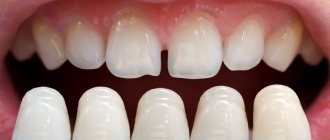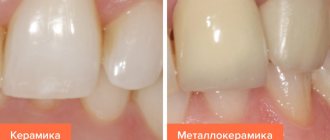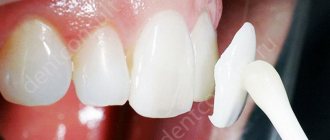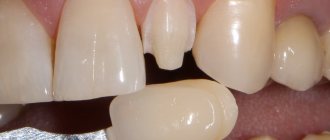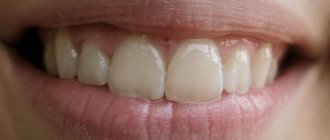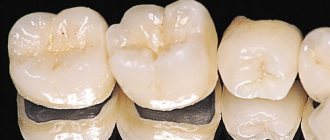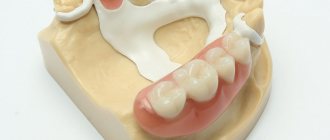Veneers – what are they?
There are two types of veneers:
- Therapeutic. Veneers are made directly on the patient’s tooth. Their composition includes composite materials that are very similar to filling materials. Often such dental devices are used for chipping (in this case, the chipping area can occupy 60%). That is, the procedure can be considered as restoration or extension of a tooth. If we do not consider the case of chipping, then under other circumstances the teeth are ground down a little, a veneer is formed, then they are ground and polished.
- Orthopedic veneers, lumineers. These materials are manufactured in a laboratory environment. In this case, an impression of the patient’s teeth must be taken. They are glued to the tooth using glue specialized for these conditions.
Therapeutic veneers are affordable for many. The price of their installation ranges from 2,500 to 15,000 rubles. The cost threshold depends on the prestige of the clinic, the characteristics of the treatment and the materials used.
Orthopedic ones are much more expensive in price than therapeutic ones. The price starts from 15,000 and goes up to 50,000 rubles. The same factors influence the price here.
Disadvantages of screw-retained crowns
The disadvantages of this method of fastening include:
- Possibility of loosening screws during operation. This nuance can be leveled out by the precise fit of the structure.
- Because screw holes are unsightly, even when masked with modern opaque composite resin, it is not recommended to choose screw fixation for lower molars and premolars.
- It is impossible to create ideal occlusal contact, since the screw hole occupies a significant part of the occlusal surface. The composite covering the screw holes wears out over time.
- The cost of screw fixation of an implant is an order of magnitude higher than fixing structures with cement.
Installation of veneers
The procedure includes several stages.
- The first stage is preliminary. At this stage, the material and color are determined.
- The second stage is preparation. The procedure involves removing hard tissue from the tooth.
- The third stage is taking an impression. An impression is taken of the tooth and sent to the laboratory.
- The fourth stage is the installation of the plate. The plate is temporary. It is made of plastic.
- The fifth stage is the production of a plaster model in the laboratory. The result is a ceramic plate.
- The sixth stage is fixation of veneers. They are fixed with special glue.
- The seventh stage is removal of cement and assessment of the occlusion.
The success of veneering largely depends on the correct fixation and the materials used.
Fixation of veneers
Three components are involved in fixing a tooth to a plate:
- hard tissues (tooth);
- fixing material for fixing veneers;
- ceramic veneer.
The adhesion strength of these components is the most important requirement in the veneering procedure.
It is very difficult to connect the components. They are all completely different materials. Ceramic veneer is an organic compound. Fixing materials are composite substances containing an inorganic filler or an organic matrix. Teeth are compounds of enamel, dentin, pulp and some others. Due to this composition, it is impossible to obtain a solid bond using a conventional chemical reaction.
Preparatory activities
Before fixation, the following steps must be completed:
- preparing the surface of the veneer itself;
- tooth surface preparation;
- preparation of fixing material (use cement for veneers).
Veneer preparation
The essence of the preparation is to create a certain roughness on the surface of the veneer, which will subsequently come into successful contact with dental tissues. How is it achieved? Hydrofluoric acid (10%) is used as an activator. The surface is etched with it for several minutes (from 1 to 4). The acid does not act on the entire surface, but in selected areas. It only dissolves silicon oxide. The result is the necessary micropores.
To improve the quality of roughness, sandblasting is often used. This process requires good skills. If you are not professional, you can damage the front surface.
Before fixing the veneer to the tooth, it is washed with water and dried.
Afterwards, a silane agent is applied to the inner surface, which gives a binding effect. Silane substances bind tightly to the adhesive and silicon oxide. Such actions are necessary for further tight bonding between the ceramic and the adhesive. The result is that the adhesive thoroughly wets the ceramic surface. Silane application time is 60 seconds. Further steps involve drying the surface using an air jet.
Tooth preparation
Cement, gel (used for fitting) and other foreign substances are carefully removed from the tooth enamel. To do this, use a sandblasting machine and rotating brushes. Afterwards, the surface is etched with phosphoric acid (37%). Acid etching creates the necessary microrelief, which further promotes adhesion. The etching exposure is 30 (40) seconds. If dentin is etched, the time is no more than 15 seconds. Its increase can provoke the collapse of collagen fibers.
When finished, wash off the phosphoric acid with plenty of water. Primer is applied to the tooth surface, left for 30 seconds and dried well. Finally, adhesive is applied. The actions are carried out simultaneously with the application of adhesive to the prepared veneer surface. This is the adhesive fixation of the veneers.
Preparation of fixation material
The fixation material is a different composite material. A wide variety of materials allows you to choose. The selected material is applied to the surface of the veneer from the inside and pressed against the tooth with careful movements. The composite material that has protruded beyond the surface of the tooth is removed. After polymerization has taken place, the tooth is ground, polished, and checked. Particular attention is paid to the adhesive seam. If this is required, then a general adjustment is made.
Cement is used as a material to fix veneers. There are many different fixation operations performed in dentistry. Unfortunately, it is not possible to use the same material everywhere. Its properties are not always suitable for fastened elements.
The ideal cement for veneers is a material that has good adhesion to the tooth structure and to the veneers themselves. And it must have the following requirements:
- resistance to various types of loads;
- ease of use and subsequent cleaning;
- insolubility in oral fluids;
- resist caries;
- even a small layer thickness should give high efficiency.
Variolink Veneer dental composite cement meets these requirements. It is intended for fixation of restorations (composite and ceramic) whose thickness does not reach 2 mm.
Variolink veneer has the following necessary and important characteristics:
- high wear resistance;
- high color fastness;
- very good consistency;
- high adhesion strength;
- high translucency;
- ease of removal.
Zirconium dioxide ceramic crowns
Zirconium dioxide is called “white gold”; this material is highly biocompatible and is not inferior in strength even to metals. It is used for the manufacture of single crowns and bridges. Such structures consist of 2 layers: an internal frame (actually made of zirconium dioxide) and porcelain mass.
There are no fundamental differences between pressed ceramics and zirconium dioxide. However, the latter option is still considered more resistant to mechanical stress.
Lumineers
The perfect (Hollywood) smile can be achieved with lumineers. The design of lumineers is slightly thinner than conventional veneers. The shape is similar to petals. To fix lumineers, veneer adhesive is used.
There are standard and individual lumineers. The former have a variety of colors and sizes. They are somewhat similar in installation to false nails. The latter are made in the laboratory depending on the individual characteristics of the patient.
Lumineers increase the volume of teeth. They are used in cases:
- Slight discoloration of teeth. The design of the devices is very thin (0.3 mm), translucent, so they cannot hide the obvious unevenness of color.
- Small diastemas between teeth. Lumineers cover them well.
- The presence of chips on the teeth and their concealment. Here, individual lumineers will be used, in which the thickness at the chip site should be greater.
- The appearance of cracks in the enamel that you want to hide.
Lumineers have a significant drawback, which manifests itself in a short service life due to low reliability. Broken material unfortunately cannot be repaired. Some procedures will need to be completed first.
A positive aspect of veneering is that the glue on which it is attached contains the element fluorine. Therefore, experts say that wearing such structures is beneficial for tooth enamel.
After installing the veneers, the dentist will invite the patient for a second appointment. This will happen in about a week. The doctor will examine your teeth and gums. He will look at how the teeth have adapted to the installed material. In addition, the doctor can perform the final steps to adjust the veneers. That is, after his manipulations, the mouth will look even better. Now it will be easier for the tooth and veneer to cope with their functions.
Crowns for central teeth: ceramics or zirconium?
Metal crowns are gradually becoming a thing of the past. Metal-ceramic options are used for molar prosthetics. The smile zone requires special treatment.
Ceramics - disadvantages
Progressive dentures for the beauty area are visually similar to natural teeth. The secret is simple: the light transmission of the material and real enamel is the same. Pressed ceramics are quite durable and allow you to create designs that create the illusion of having “living” beautiful teeth.
But ceramics have a number of disadvantages
:
- The material is more fragile than its zirconium counterpart or with a metal frame. Its durability is close to real enamel. When using the front teeth as a tool or biting hard objects (for example, nuts), there is a high risk of chipping or breaking the crown and the covered tooth.
- Not suitable for restoration of molars - does not withstand intense chewing load. Not suitable for bridges.
- The crowns are translucent. If a real tooth is dark in color, it may be visible through the ceramic layer.
- You cannot place a ceramic crown on a tooth with a metal core insert installed; the alloy will be noticeable.
- High cost. But it pays off - there is no risk of seeing metal when the gums recede, teeth look more beautiful than those given by nature.
Since there are more advantages than problems, the service life of ceramics is long, there is no risk of staining, they are deservedly popular among patients.
Zirconium: features
White zirconium is durable, suitable for molar prosthetics, withstanding loads with honor. But it is reasonable to place crowns on the front teeth with a ceramic coating. This way the frontal units will be as stable as possible, visually close to natural enamel.
Zirconium is aesthetically pleasing, but its light reflectivity is slightly different. The patient's smile will not be perfect. The material can be used to make bridges of any complexity, including for the front teeth. Zirconium, like ceramics, is hypoallergenic and biocompatible with body tissues. The disadvantage of such prostheses is the price.
How much does a zirconium crown cost per tooth? From 27,900 rubles per unit.
Situation: veneer failed
In practice, there were cases when the veneer fell off. How to fix? You need to assess the situation and carefully study the problem, and the doctor will suggest a solution.
If the material has simply peeled off, then you need to remove it with careful movements (so as not to damage it).
If you see in your mouth that one part has peeled off, then there is a possibility that the device remains intact. If the veneer falls off as a whole, then the doctor will definitely be able to fix it in place.
In case of obvious breakdown of the material, the dentist will have no other solution but to replace it with a new one.
How can you tell if the entire veneer has fallen off? You need to look at the condition of the fallen element. If it has a symmetrical and rounded shape, then the veneer is intact. If you look closely at the tooth and see a residue on it, then the veneer is 100% broken.
In order to help the dentist with further treatment, you must show him the fragments. It is recommended to save all parts of the broken material. To do this, you need to fill a small box with cotton wool and put the debris there.
Next, you need to report the incident to the doctor. The doctor will solve the problem. But in general, the potential risk of such a problem is small. The tooth will remain without protection for some time (two weeks). There will be no significant changes in him for weeks.
Veneer detachment can be detected independently. It happens that you feel a rough surface (as opposed to a smooth veneer) in your mouth. The tip of the tongue undergoes irritation. And yet, a ground tooth will definitely react to temperature changes, since the surface has no protection.
And in the future, carefully analyze the situation and determine what actions you took could cause the breakdown. Once you find the answer, never repeat such actions again. If you cannot determine, consult your dentist.
Features of screw fixation of crowns
The following features are typical for fastening orthopedic structures with screws:
- On the occlusal surface of the crown there is a seat for a screw, thanks to which the components are connected.
- The complexity of prosthetics in the case of vestibular inclination of the implant in the aesthetic zone. In such a situation, experts may give preference to the cement method of fastening.
- Screw fastening is preferable when it is necessary to manufacture long orthopedic structures. In such a situation, screw fixation of the prosthesis on implants has no better alternatives.
- All structural elements can be replaced without causing negative biological effects.
- It is difficult to prepare structures due to the fact that inaccuracies can cause chips of ceramics and broken screws. The level of manual skills of the dental technician and orthopedist is important.
Care
If you take special care of your veneers, you can wear them for decades. In this case, of course, it is necessary to undergo preventive examinations. What are the care activities? They need to be cleaned thoroughly twice a day. You can use both a brush and paste.
Veneers are installed for cosmetic purposes. It should be remembered that the strength of the material is low, so you need to take care of their condition. It is necessary to ensure that bad habits (for example, biting nails) do not find a place in the patient’s life. In addition, you should not consume foods that are colored (for example, coffee, tea).
Sources used:
- “Aesthetic dentistry and ceramic restorations (Tuati B.)
- Criteria for evaluating composite dental restorations / A.I. Nikolaev and others - M.: MEDpress-inform, 2015.
- “Adhesive ceramic restorations” (Manier P.)
- National Library of Medicine (USA)
Advantages
- unsurpassed aesthetic result (in addition to the above, there is also no dark stripe at the border of the crown and gum, which can spoil the smile when prosthetics of the front teeth are made with metal-ceramic structures);
- proximity of the material to natural teeth in terms of physical properties (thermal conductivity, expansion coefficient when heated, hardness, etc.);
- a metal-free crown is thin and light, does not require a large amount of tooth preparation (grinding), the patient quickly adapts to it (literally in a few days);
- harmlessness, complete biocompatibility - a metal-free crown is chemically inert, does not cause a galvanic effect, allergic reactions, intoxication, or irritation;
- durability (service life of at least 10 years), resistance to staining, darkening;
- comfort and ease of hygienic care.
Metal-free ceramics E-max
Metal-free ceramic crowns made using E-Max technology are one of the most advanced aesthetic ways to restore teeth in various clinical situations. The technology for manufacturing E-max ceramics was relatively recently developed by German scientists and has already deservedly enjoyed the trust of dentists and demand among patients all over the world. The material from which crowns are made contains less glass-like filler, and its lattice contains microscopic particles of leucite. It is the size of these particles that matters: the smaller the particles in the chemical lattice, the stronger the material.
E-Max ceramic crowns are not only durable (they demonstrate excellent functional qualities), but also very beautiful. Aesthetic inlays and veneers are also successfully produced using the E-max technology.
Advantages of E-Max metal-free ceramics:
- High aesthetics. The crown looks extremely beautiful even in comparison with other types of ceramic crowns. Moderate transparency and natural fit to the gum allow this technique to be used for making veneers.
- Biocompatibility with oral tissues. E-Max metal-free crowns are completely safe for allergy sufferers.
The disadvantage of E-max dental crowns is their high cost.
Indications and contraindications
Indications for the use of metal-free ceramics include the following clinical cases:
- aesthetic disorders - chips, enamel defects, underdevelopment of the front molars, existing gaps in the frontal zone, distortion of the shape, the absence of one or more teeth, exposed and darkened neck;
- congenital anomalies of the dentition;
- replacement of outdated or worn restorations, broken fillings;
- severe damage to dental tissues caused by extensive caries;
- prosthetics in cases of allergic reactions to metal frame structures.
Contraindications to the use of metal-free ceramics:
- abnormal, deep bite;
- low clinical height of teeth (small teeth);
- the presence of acute conditions in chronic diseases;
- weakened immune system;
- pregnancy;
- frequently recurring attacks of bruxism (teeth grinding), leading to crowding, unevenness, and changes in the shape of the crown of the tooth;
- progressive osteoporosis;
- acute or chronic inflammation of the oral mucosa, periodontal disease, gingivitis.
